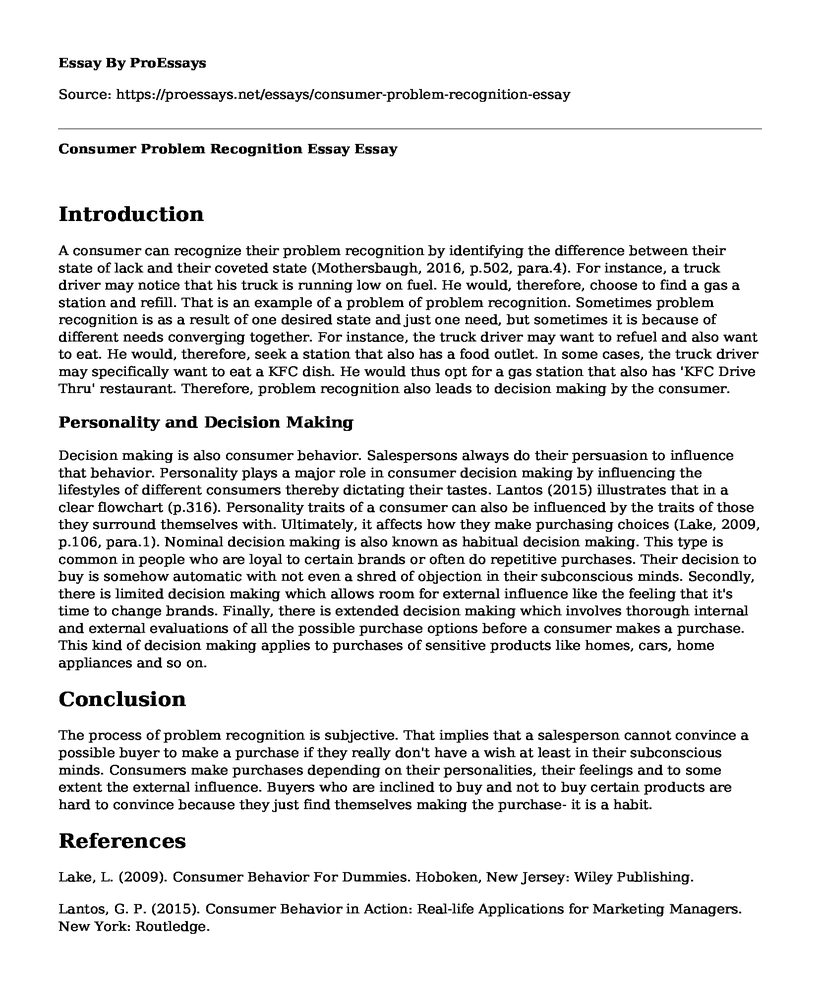Introduction
A consumer can recognize their problem recognition by identifying the difference between their state of lack and their coveted state (Mothersbaugh, 2016, p.502, para.4). For instance, a truck driver may notice that his truck is running low on fuel. He would, therefore, choose to find a gas a station and refill. That is an example of a problem of problem recognition. Sometimes problem recognition is as a result of one desired state and just one need, but sometimes it is because of different needs converging together. For instance, the truck driver may want to refuel and also want to eat. He would, therefore, seek a station that also has a food outlet. In some cases, the truck driver may specifically want to eat a KFC dish. He would thus opt for a gas station that also has 'KFC Drive Thru' restaurant. Therefore, problem recognition also leads to decision making by the consumer.
Personality and Decision Making
Decision making is also consumer behavior. Salespersons always do their persuasion to influence that behavior. Personality plays a major role in consumer decision making by influencing the lifestyles of different consumers thereby dictating their tastes. Lantos (2015) illustrates that in a clear flowchart (p.316). Personality traits of a consumer can also be influenced by the traits of those they surround themselves with. Ultimately, it affects how they make purchasing choices (Lake, 2009, p.106, para.1). Nominal decision making is also known as habitual decision making. This type is common in people who are loyal to certain brands or often do repetitive purchases. Their decision to buy is somehow automatic with not even a shred of objection in their subconscious minds. Secondly, there is limited decision making which allows room for external influence like the feeling that it's time to change brands. Finally, there is extended decision making which involves thorough internal and external evaluations of all the possible purchase options before a consumer makes a purchase. This kind of decision making applies to purchases of sensitive products like homes, cars, home appliances and so on.
Conclusion
The process of problem recognition is subjective. That implies that a salesperson cannot convince a possible buyer to make a purchase if they really don't have a wish at least in their subconscious minds. Consumers make purchases depending on their personalities, their feelings and to some extent the external influence. Buyers who are inclined to buy and not to buy certain products are hard to convince because they just find themselves making the purchase- it is a habit.
References
Lake, L. (2009). Consumer Behavior For Dummies. Hoboken, New Jersey: Wiley Publishing.
Lantos, G. P. (2015). Consumer Behavior in Action: Real-life Applications for Marketing Managers. New York: Routledge.
Mothersbaugh, D. L. (2016). Consumer Behavior, Building Marketing Strategy(13th ed.). New York: McGraw Hill Education.
Cite this page
Consumer Problem Recognition Essay. (2022, Apr 15). Retrieved from https://proessays.net/essays/consumer-problem-recognition-essay
If you are the original author of this essay and no longer wish to have it published on the ProEssays website, please click below to request its removal:
- Understanding "Comfort" and "Discomfort" in an Interview Essay
- Information Sensitivity and Protection of Data Essay
- Change Management Position Paper Example
- Cultural Adaption: Essential for Leadership in Global Contexts - Essay Sample
- Strategic Management in Omantel Company: An Essay Example
- Essay Example on the American Economy After Blind Consumption: Brian Ulrich's Caption
- Report Sample on Covid-19 and the New Leadership







